Ijraset Journal For Research in Applied Science and Engineering Technology
- Home / Ijraset
- On This Page
- Abstract
- Introduction
- Conclusion
- References
- Copyright
Energy Performance and Optimization of Commercial Building under Composite Climate using BIM
Authors: Ekta Dwivedi, Pankaj Kumar, Rahul Jha, Dhruv Mehra
DOI Link: https://doi.org/10.22214/ijraset.2024.57883
Certificate: View Certificate
Abstract
The use of BIM REVIT for Energy Performance and Optimisation of Buildings (EPOBs) has been shown in this research to be a sustainable and energy-efficient response to the problems posed by climate change and growing energy expenses. These buildings are made to produce as much energy as they consume, ensuring that their net energy consumption is zero. The paper explores the evolution of energy performance and optimisation of buildings and the latest emerging technologies that are enabling their development, comprising innovative sensors, lightweight insulation panels, energy-efficient lighting and HVAC systems, building integrated photovoltaic (BIPV) systems, and smart building automation systems. The effectiveness of these strategies is analysed using Autodesk insights and Revit software. In order to ascertain the effectiveness of energy-efficient and renewable energy strategies, the article also compares energy use intensity (EUI) before and after implementation. The proposed building achieved a significant 44.3% reduction in energy consumption after implementing various energy performance and Optimization strategies for commercial building design, resulting in a mean EUI value of -33.1 kWh/sq. m/year. The analysis was conducted using Autodesk Insights and Revit software, utilising the Building Information Modelling (BIM) approach for building design. This paper concludes with a discussion on the future of energy performance and optimisation and how they are an important step towards achieving sustainable and efficient energy use in the building sector, resulting in cost savings and reducing carbon emissions.
Introduction
I. INTRODUCTION
In 2019, the energy landscape of the United States witnessed a substantial impact from the energy consumption of residential and commercial buildings, accounting for over 39.2% of the nation's total energy and a significant 71.1% of electrical energy[1]. According to the International Energy Outlook 2023 worldwide energy consumption in the building sector will increase by an average of 1.5% per year between 2012 and 2040[1] . A Global Pathway to Keep the 1.5 °C Goal in Reach, the IEA update to the landmark Net Zero by 2050 Roadmap, was published in September 2023 (IEA, 2023b)[1]–[4]. The updated Net Zero Emissions by 2050 (NZE) Scenario is incorporated in full in this Outlook[5]. It reached the conclusion that the pathway to net zero emissions by 2050 has narrowed since the first version published in 2021, but that it remains feasible[2], [6]. In this section, we highlight four reasons why this pathway remains open and look at four areas that require urgent attention if the promise of a 1.5 °C limit on global warming is to be realised[7]. This underscored the imperative to address energy use intensity, leading to the development of emerging technologies. These encompassed various sectors, including HVAC systems, water heating, appliances, windows, solid-state lighting, grid-interactive buildings, sensors, controls, and building energy modelling, all aimed at reducing energy consumption and enhancing efficiency[2], [8]. The conventional approach to evaluating energy performance faced significant challenges, characterized by manual simulations that often resulted in error-prone data duplication, leaks, and redundant data processing and storage[9]–[11]. The introduction of Building Information Modelling (BIM) emerged as a transformative solution. BIM operates as a dynamic data model, seamlessly integrating 3D digital techniques with diverse information throughout a building's life cycle[12]. This integration facilitates swift energy model generation by capitalizing on existing data, eliminating the pitfalls of traditional approaches[13]. Moreover, the parametric nature of BIM enables the efficient incorporation of suggested changes to the energy model, providing a dynamic and adaptable platform for continuous energy performance measurement. Shifting the focus to Iran, a considerable amount of energy is annually consumed in the household, public, and commercial sectors, with buildings contributing to 34% of total energy consumption in 2016[2], [14], [15].
The need to optimize energy consumption in Iran has emphasized the role of BIM in providing accurate analyses of thermal and cooling loads during the design phase. Despite various research initiatives on BIM adoption for energy efficiency, there remains a research gap in simultaneously evaluating building components through BIM technology, especially during the conceptual design phase[16]. In India, recent data reveals a total installed capacity of 152.31 Million Tonne per year in coal washeries as of March 31, 2022, comprising 37.18 MTY in coking and 115.13 MTY in Non-Coking Coal Washeries. The refining sector, with a capacity of 2,51,216 TMTPA, experienced a notable 9% increase in production during 2021-22[17]. Public sector refineries dominate, displaying a robust capacity utilization increase to 96.99%[17]. The emphasis on increasing electricity generation capacity aligns with global commitments to sustainability and the growing energy demands in densely populated regions[2], [8], [15]. The chapter underscores the global commitment to sustainable energy services, as reflected in the Sustainable Development Goals (SDG Target 7.B). India's policy planning revolves around generating reliable power sustainably, with a thrust to increase installed generating capacity while decreasing reliance on primary fossil fuels. It is crucial to note the nuances of capacity translating into actual power generation, emphasizing the significance of sustainable practices and the adoption of clean energy systems in the broader context of global energy challenges[6], [15].
II. METHODOLOGY
The Energy Performance and Optimization of Commercial Buildings (EPOCBs) aims to attain a balance between energy consumption and energy generation, resulting in zero net energy consumption. This is accomplished by utilising renewable energy sources, energy-efficient design concepts, and the most recent, innovative energy-efficiency technologies[18]–[20].A comprehensive analysis of the building’s various aspects was conducted and compared with other emerging technologies to ensure maximum optimization. This research outlines the process undertaken to design the net zero energy building, which is illustrated in the accompanying figure 1.
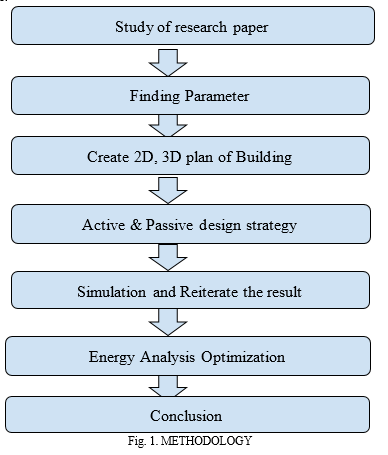
Following are the design strategies we have applied for Energy Performance and Optimization of Proposed Buildings (EPOBs):
- Passive Design Strategy: The goal of passive design principles is to use passive methods to lower a building's consumption of energy[16]. These strategies include optimizing the building’s orientation, using shading devices to control solar gain, maximizing natural daylight, and minimizing air leakage. By minimizing the energy required to heat, cool, and light the building, passive design strategies can significantly reduce the energy consumption of a building[21].
- Active Design Strategies: Active design strategies are design strategies that rely on the use of active systems and technologies to achieve net zero energy consumption in buildings. These strategies concentrate on the production, allocation, and management of energy throughout the building[22]. Examples of active design strategies include geothermal heating and cooling systems, CTMA3 (Dexa Cetyltrimethylammonium Chloride) Technology efficient lighting systems, efficient HVAC systems, and building automation and control systems. These strategies are critical to achieving net zero energy consumption and reducing the environmental impact of buildings.
- Renewable Energy Design Strategy: Energy Performance and Optimization of Commercial Buildings (EPOCBs) depends upon the effectiveness of the Renewable Energy System Design Strategy. The size of a Solar Photovoltaic Power Plant is calculated depending upon the requirement of power and availability of shadow-free roof area [10]. The solar modules mounted on the building capture solar energy at converting it into electricity
Notes: CTMA3: Introducing the advanced CTMA3 Air purification technology that purifies your living spaces, while killing any germs and viruses from the environment, giving you pure air to breathe, and clean surfaces to live at. Natural biological proteins collagen hydrolysate acts as dielectric material due to the presence of hydroxyl groups. Cationic surfactant hexadecyltrimethylammonium chloride (CTMA) is added into collagen hydrolysate to form a dielectric layer in a bio thin film transistor (BioTFT) device. Experimental results highlight that the collagen-CTMA mixture at 3 wt% (Col-CTMA3) has shown an average mobility of 3.36 × 10−2 cm2V−1s−1 and an on/off ratio up to 2.7 × 106.1-aminopyrene is embedded into Col-CTMA3 mixture to form Col-CTMA3-1-aminopyrene (Col-CTMA3-AP) mixture to fabricate bio field-effect transistor (BioFET) type memory device. Furthermore, the optimized addition of 1-aminopyrene in the Col-CTMA3-AP mixture for memory device has provided enhanced performances associated to an average mobility of 1.23 × 10−2 cm2V−1s−1, an on/off ratio up to 5.22 × 105 and a memory window of 13.6 V, as the proportion of 1-aminopyrene increased, the charge-trapping ability of collagen strengthened. Studies on the effects of the environment have revealed that BioFET memory devices submerged in water emphasise the importance of the hydroxyl group in enhancing BioFET performance.
A. Building Details
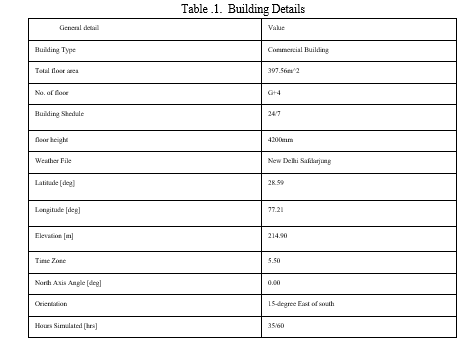


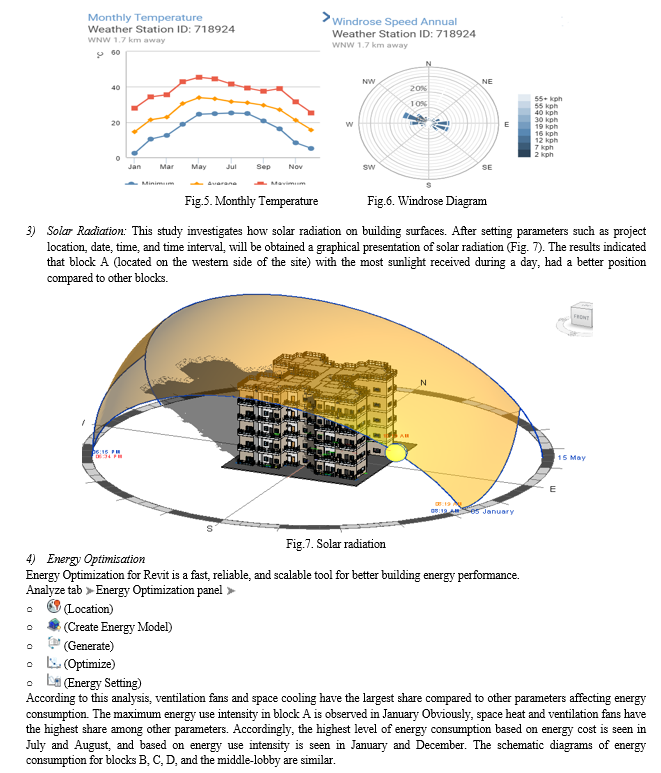
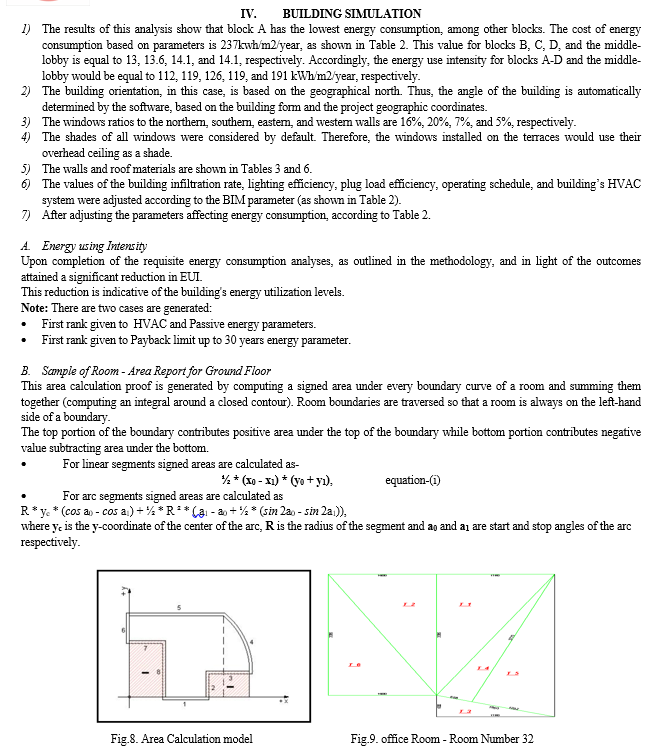
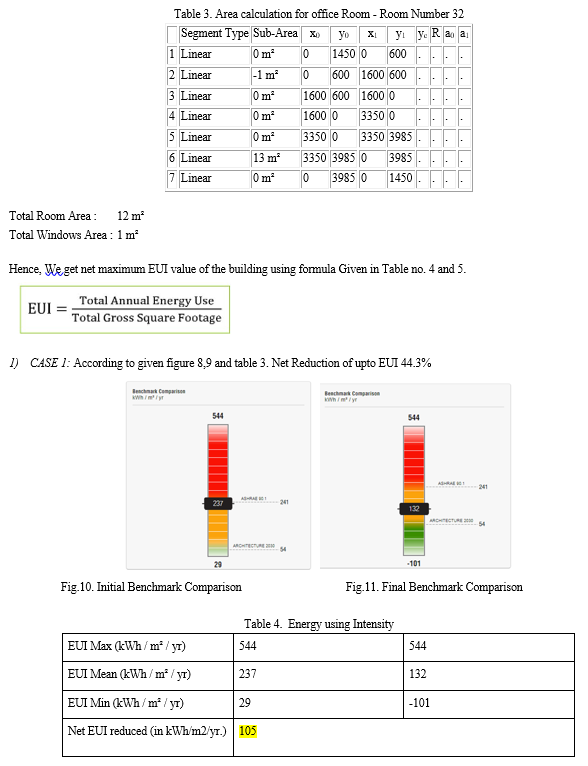

Conclusion
By utilising several tactics including building orientation, WWR, etc., this study seeks to identify the most effective design strategies for lowering cooling demand, refrigerant demand, and energy consumption in office buildings in diverse regions. 1) By applying the first example, it was discovered that the building performance in New Delhi Safdarjung had improved by 44.3%. A 30-year repayment restriction is applied in Cases 1 and 2, respectively. We obtain a mean EUI score of -31.3%, indicating net zero energy construction. 2) In New Delhi Safdarjung, optimising the building orientation, WWR, window shades and glazing, and roof characteristics produced the greatest impact. 3) On the other hand, New Delhi\\\'s maximum energy consumption decrease of 40.86% was made possible by optimising lighting efficiency and management. 4) In office buildings across various temperature zones, the average reduction in EUI, annual energy consumption, and annual energy peak demand is determined to be -31.3 kWh/m2/yr,0 kWh/m2/yr and 90.8 kWh/m2/yr respectively.
References
[1] Dr Fatih Birol, “World Energy Outlook 2023,” France , Oct. 2022. [Online]. Available: http://www.iea.org/terms [2] A. H. Alhamami, Y. A. Dodo, A. U. Naibi, A. Alviz-Meza, and A. Mokhtarname, “Energy-carbon emission nexus in a residential building using BIM under different climate conditions: an application of multi-objective optimization,” Front. Energy Res., vol. 11, 2023, doi: 10.3389/fenrg.2023.1326967. [3] Z. Deng, K. Javanroodi, V. M. Nik, and Y. Chen, “Using urban building energy modeling to quantify the energy performance of residential buildings under climate change,” Build. Simul., vol. 16, no. 9, pp. 1629–1643, Sep. 2023, doi: 10.1007/s12273-023-1032-2. [4] P. Elsayed, H. Mostafa, and M. Marzouk, “BIM based framework for building evacuation using Bluetooth Low Energy and crowd simulation,” J. Build. Eng., vol. 70, p. 106409, Jul. 2023, doi: 10.1016/j.jobe.2023.106409. [5] A. Zhao, Y. Jiao, W. Quan, and Y. Chen, “Net zero carbon rural integrated energy system design optimization based on the energy demand in temporal and spatial dimensions,” Renew. Energy, p. 119818, Dec. 2023, doi: 10.1016/j.renene.2023.119818. [6] G. Yao, Y. Chen, Y. Lin, and Y. Wang, “Energy-Saving Design Strategies of Zero-Energy Solar Buildings—A Case Study of the Third Solar Decathlon China,” Buildings, vol. 13, no. 2, Feb. 2023, doi: 10.3390/buildings13020405. [7] Y. S. Kim and C. S. Park, “Real-time predictive control of HVAC systems for factory building using lightweight data-driven model,” J. Build. Perform. Simul., vol. 16, no. 5, pp. 507–525, Sep. 2023, doi: 10.1080/19401493.2023.2182363. [8] X. Xu, T. Mumford, and P. X. W. Zou, “Life-cycle building information modelling (BIM) engaged framework for improving building energy performance,” Energy Build., vol. 231, Jan. 2021, doi: 10.1016/j.enbuild.2020.110496. [9] T. E. Seghier, Y.-W. Lim, M. F. Harun, M. H. Ahmad, A. A. Samah, and H. A. Majid, “BIM-based retrofit method (RBIM) for building envelope thermal performance optimization,” Energy Build., vol. 256, p. 111693, Feb. 2022, doi: 10.1016/j.enbuild.2021.111693. [10] E. Dwivedi, “Energy Performance and Optimization of commercial Building under different Outdoor Climate and geographical location using BIM REVIT”. [11] K. S. Reddy and C. Ananthsornaraj, “Design, development and performance investigation of solar Parabolic Trough Collector for large-scale solar power plants,” Renew. Energy, vol. 146, pp. 1943–1957, Feb. 2020, doi: 10.1016/j.renene.2019.07.158. [12] D. M. Barbieri, B. Lou, M. Passavanti, A. Barbieri, and F. Bjørheim, “A Survey Dataset Evaluating Perceptions of Civil Engineering Students about Building Information Modelling (BIM),” Data, vol. 8, no. 7, p. 114, Jun. 2023, doi: 10.3390/data8070114. [13] “Energy Performance Analysis of Building for Sustainable Design Using Bim: A Case Study on Institute Building,” Int. J. Renew. Energy Res., no. v11i2, 2021, doi: 10.20508/ijrer.v11i2.11825.g8222. [14] M. Muhammad Abdul Mujeebu and F. Farheen Bano, “Integration of passive energy conservation measures in a detached residential building design in warm humid climate,” Energy, vol. 255, no. 10.1016/j.energy.2022.124587, p. 124587, Sep. 2022, Accessed: Dec. 30, 2023. [Online]. Available: http://dx.doi.org/10.1016/j.energy.2022.124587 [15] M. Swathi, “The Energy to Change: A Sustainable World,” BIOLOGICO, pp. 01–07, Feb. 2022, doi: 10.36099/biologico.220122. [16] E. Sorooshnia, P. Rahnamayiezekavat, M. Rashidi, M. Sadeghi, and B. Samali, “Passive Intelligent Kinetic External Dynamic Shade Design for Improving Indoor Comfort and Minimizing Energy Consumption,” Buildings, vol. 13, no. 4, p. 1090, 2023, doi: 10.3390/buildings13041090. [17] R. Roman Maršálek, “Zeta potential measurements for adsorption capacity calculation: case study for a system of natural coal and surfactants,” Int. J. Oil, Gas Coal Technol., vol. 31, no. 10.1504/ijogct.2022.125365, 2022. [18] M. Abdul Mujeebu and F. Bano, “Energy-saving potential and cost-effectiveness of active energy-efficiency measures for residential building in warm-humid climate,” Energy Sustain. Dev., vol. 67, pp. 163–176, Apr. 2022, doi: 10.1016/j.esd.2022.01.011. [19] R. Liu, Z. Liu, W. Xiong, L. Zhang, C. Zhao, and Y. Yin, “Performance simulation and optimization of building façade photovoltaic systems under different urban building layouts,” Energy, vol. 288, p. 129708, Feb. 2024, doi: 10.1016/j.energy.2023.129708. [20] S. Saidazimov and N. Yoqubova, “The role and importance of information technologies in the development of New Uzbekistan,” ??????????? ????????? ?????????????? ???????? ????? ? ??????????? ? ?????????? ????, vol. 1, no. 1, pp. 240–243, Mar. 2023, doi: 10.47689/STARS.university-pp240-243. [21] V. Badescu, “How much work can be extracted from diluted solar radiation?,” Sol. Energy, vol. 170, pp. 1095–1100, Aug. 2018, doi: 10.1016/j.solener.2018.05.094. [22] N. Galkina, O. Gurova, and M. Govorunov, “BIM technologies for the design of active solar heating systems,” IOP Conf. Ser. Mater. Sci. Eng., vol. 1001, no. 1, 2020, doi: 10.1088/1757-899X/1001/1/012102. [23] C. Ji, T. Hong, H. Kim, and S. Yeom, “Effect of building energy efficiency certificate on reducing energy consumption of non-residential buildings in South Korea,” Energy Build., vol. 255, p. 111701, Jan. 2022, doi: 10.1016/j.enbuild.2021.111701. [24] X. Wang, Li, Luo, Wang, and S. P. Shah, “A critical review on phase change materials (PCM) for sustainable and energy efficient building: Design, characteristic, performance and application,” Energy Build. , vol. 260, no. 1 April 2022, 2022. [25] B. Kavitha and M. . Molykutty, “Life cycle energy analysis of a glazed commercial building using building information modelling (BIM) tools,” Mater. Today Proc., vol. 37, pp. 940–946, 2021, doi: 10.1016/j.matpr.2020.06.148. [26] Y. Li, X.-P. Wu, Q.-S. Li, and K. F. Tee, “Assessment of onshore wind energy potential under different geographical climate conditions in China,” Energy, vol. 152, pp. 498–511, Jun. 2018, doi: 10.1016/j.energy.2018.03.172. [27] C. Baglivo, P. M. Congedo, G. Murrone, and D. Lezzi, “Long-term predictive energy analysis of a high-performance building in a mediterranean climate under climate change,” Energy, vol. 238, p. 121641, Jan. 2022, doi: 10.1016/j.energy.2021.121641. [28] Y. Li, Y. Yoon, Y. Bae, and P. Im, “Evaluation of thermostat location for multizone commercial building performance,” J. Build. Eng., vol. 70, p. 106212, Jul. 2023, doi: 10.1016/j.jobe.2023.106212.
Copyright
Copyright © 2024 Ekta Dwivedi, Pankaj Kumar, Rahul Jha, Dhruv Mehra. This is an open access article distributed under the Creative Commons Attribution License, which permits unrestricted use, distribution, and reproduction in any medium, provided the original work is properly cited.

Download Paper
Paper Id : IJRASET57883
Publish Date : 2024-01-04
ISSN : 2321-9653
Publisher Name : IJRASET
DOI Link : Click Here
 Submit Paper Online
Submit Paper Online

